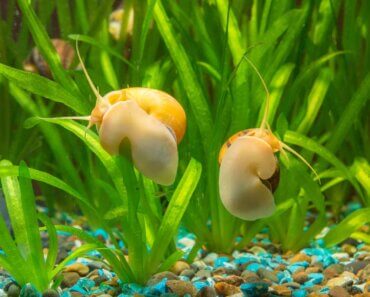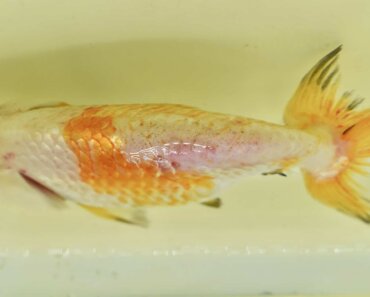Choosing the right size fish tank is critical. It will dictate where you can place it, what you can put in it, and how you will manage it.
But what are the weights and dimensions of different-sized aquariums, and how many fish can you keep in them?
Here I’ll answer your biggest questions on fish tank sizes.
Why Size Matters
The size of your aquarium is obviously one of the biggest decisions when buying a new tank. You have to understand where you’d like to place it, and how much weight it will exert on whatever you plan to place it on.
The size of your tank also determines how much substrate, décor, and plants you’ll need. If you’re buying just the tank, it’ll also changes which filter, heater, hood, and lights you’ll need to choose.
Larger tanks tend to require more maintenance, but interestingly, they’re easier to regulate stable water conditions in than small tanks.
And finally, the size of your tank will determine how many fish you can keep. This is known as ‘stocking density’ and we’ll discuss this more later on.
Aquarium Weight
Aquariums often weigh more than people think. I remember placing my first 75-gallon tank on top of a long wooden desk. With time, the desk started to sag, and the situation was luckily saved by my handyman uncle who secured some wooden supports under the desk to avoid disaster!
It’s important to know how much your aquarium will weigh once it’s filled with substrate, décor, and water, and whether the structure you’re planning to place it on top of is sufficiently sturdy to safely support it for the duration of the tank’s time there.
Glass Aquarium Dimension and Weight Table
Here are some examples of common tank sizes, their dimensions, their empty weight (assuming it’s a glass aquarium), and their weight when filled with typical substrate, ornaments, and water.
Click on any tank sizes with links attached to check out our buyer’s guide to tanks of that size.
| Tank Size | Dimensions (LxWxH) | Empty Weight | Filled Weight |
|---|---|---|---|
| 2 1/2 Gallon | 12? x 6? x 8? | 3 lbs | 27 lbs |
| 5 Gallon | 16? x 8? x 10? | 7 lbs | 62 lbs |
| 10 Gallon | 20? x 10? x 12? | 11 lbs | 111 lbs |
| 15 Gallon | 24? x 12? x 12? | 21 lbs | 170 lbs |
| 20 Gallon | 24? x 12? x 16? | 25 lbs | 222 lbs |
| 30 Gallon | 36″ x 16″ x 16″ | 48 lbs | 350 lbs |
| 40 Gallon (Long) | 48? x 12? x 16? | 60 lbs | 455 lbs |
| 50 Gallon | 36? x 18? x 19? | 100 lbs | 600 lbs |
| 75 Gallon | 48? x 18? x 21? | 140 lbs | 850 lbs |
| 90 Gallon | 48” x 18” x 24” | 160 lbs | 1010 lbs |
| 125 Gallon | 72? x 18?x 21 | 205 lbs | 1250 – 1400 lbs |
| 180 Gallon | 72? x 24?x 25? | 400+ lbs | 1900 – 2100 lbs |
| 225 Gallon | 72? x 27.5? x 27.5? | 400+ lbs | 2160+ lbs |
Fish Tank Weight Calculator
The above table is only to give you an approximate idea of aquarium weight, based on typical dimensions and setup. For a more accurate understanding of your aquarium’s weight, you’ll need to know how to calculate it.
To do that, we need to add together the three main components: weight of tank, weight of substrate and ornaments, and weight of water.
Weight of Tank
First, we need to find the weight of the empty tank. This will depend on the type of tank since acrylic fish tanks only weigh around 55% of the weight of glass. Check out our table above to see typical empty weights of glass aquariums.
Weight of Substrate and Ornaments
Once you know your aquarium’s empty weight, you can add the weight of your substrate and decor. As a general rule, the weight of substrate and ornaments in a typical glass aquarium will weigh slightly more than the weight of the tank.
Of course, this will depend on the type and weight of the substrate you choose, and how many rocks you include.
Weight of Water
By far and away your greatest weight consideration is your water. A 5-gallon tank will only weigh around 20 lb when filled with rocks and substrate, but add water to it, and it’ll weigh around 60lb!
One gallon of water weighs 8.34lb, so we can easily calculate the weight of the water by multiplying the number of gallons by 8.34.
Example Calculation
- We start by finding out the weight of an empty 20-gallon glass tank – that’s 25lb.
- We then add substrate, rocks, and décor to the tank, weighing another 30lb.
- Then find out the weight of 20 gallons of water by multiplying 20 x 8.34 = 166.8lb (let’s round up to 167 lb)
- Finally, we add the three figures together: 25 + 30 + 167 = 222lb
How Do I Find Out the Weight of an Acrylic Aquarium?

If you are looking at buying an acrylic aquarium but the weight is not listed, you can find out the approximate weight by finding 55% of the glass weights listed above.
For example, a 10-gallon glass tank weighs 11lb. To find out the weight of an acrylic tank of the same size, multiply 11 x 0.55 = 6.05lb
Aquarium Dimensions
Using the table below, you can find out the dimensions of regular-sized fish tanks.
Dimensions for each tank volume are often standardized in the aquarium industry, but of course, there is some room for variation so it’s worth checking the specifications from the manufacturer.
While most types of tank are rectangular and prioritize water surface area, there are also taller designs, as well as some creative shapes you can try.
Long Aquariums vs Deep/High Aquariums
Most aquarium dimensions prioritize length over depth. Why? A long front panel of glass gives an excellent viewing experience, as well as more horizontal-line swimming space for your fish.
Almost all fish prefer to swim in horizontal lines, and a long aquarium gives them more space to swim without needing to turn around. This is especially important for open water swimmers like danios and rasboras, and longer aquariums can stock more fish than taller aquariums of the same volume too.
On the other hand, taller aquariums have the advantage of taking up less surface space, so can be useful if you want an aquarium that you can squeeze onto your desk or small cabinet. They also tend to have better levels of dissolved oxygen, since there is more vertical space for bubbles to dissolve and enrich the water.
You’ll need to make sure your support is strong, however, since taller tanks exert a greater pressure per surface area than shallower tanks.
Taller tanks are also more difficult to aquascape since there’s less substrate space, and cleaning the gravel can be really difficult – it’s a long old way to reach down!
Rectangular vs Hexagon Aquariums
There are some interesting hexagonal aquariums on the market that provide a novel way of watching the underwater world. In general, hexagonal designs are fairly tall, with the same limitations that we discussed above.
While a few species such as puffer fish seem to enjoy swimming vertically, most fish will find the horizontal swimming constraints of a tank like this stifling.
All of the extra angles in a hexagon also limit you when you try to see the entire tank from a single pane of glass, and the other angles will distort your view.
Flat Front vs Bow Front Aquarium
Some fish tanks come with a curved front pane of glass or acrylic, as opposed to the conventional flat front. What’s the advantage? Aesthetic mainly, some people like the novelty and style of a bowed front panel.
You can also see through the front pane from a greater variety of angles.
But, be warned, it might give you a headache looking at your fish – I mean literally! Because of the distortion caused by the curved glass, some people find their eyes and head ache when they try to focus and make sense of what they’re seeing.
They’ll also distort your photos. If you’re one of those fish keepers who like to spend hours watching or taking pictures of the underwater world, you might be better off with the flat-fronted option.
Stocking Density
As I mentioned earlier, your aquarium size will affect how many fish you can fit in it.
There are two basic formulas to work this out.
- The one-inch per gallon formula (good for small fish)
The conventional way to see how many fish you can stock in a given tank is one inch of fish per gallon of water. This means if you have a 15-gallon tank, you can fit a combined total of 15 inches of fish in it.
For example: To find out how many neon tetras could fit our 15-gallon tank, simply divide 15 by the length of our neon tetras – 1.5 inches. 15/1.5 = 10. Very neat, our 15-gallon tank could host a maximum of 15 neon tetra, assuming there are no other fish in the tank.
While this formula works well for small fish, it doesn’t work so well for larger fish! If any of your fish are more than 4 inches long, try the next formula instead.
- The 12 square inches of aquarium floor area per inch of fish formula (better for large fish)
This formula was pioneered by legendary aquarist Dick Mills, and is sometimes known as the ‘Dick Mills Golden Rule’. It states that you need 12 inches of aquarium floor area (or water surface area) per inch of fish.
For example, in a 20-gallon tank that is 24” long x 12” wide, our floor area would be 24 x 12 = 360 square inches. We divide this again by 12 = 24
This means we can keep a combined total of 24 inches of fish in a tank of this size.
Best Tank Sizes
Best Tank Size for Beginners
People sometimes imagine that smaller tanks are better for beginners. But very small tanks are actually famous for being very difficult to manage and maintaining stable water conditions.
Beginners are recommended to go for medium-sized aquariums of between 20 – 40 gallons, with a rectangular shape and standard dimensions to keep things simple.
The extra water will make it much easier for you to manage good biological filtration and avoid ammonia spikes, shifts in temperature, and other shocking events for your fish.
Best Tank Size for Betta Fish
While some people have kept betta fish in fish bowls and 2.5-gallon tanks, I definitely wouldn’t recommend it. Betta fish kept in such cramped conditions are notoriously short-lived and are prone to health problems and even depression.
A 5-gallon tank is the smallest tank size to responsibly keep a betta fish in. If you’re a beginner, consider getting a 20-gallon tank with some shrimps and snails to give your betta some company.
Best Tank Size for Goldfish
Goldfish also need much bigger tanks than people often realize. While you can keep a baby goldfish in a 20-gallon tank, remember that they can grow up to 16 inches long and produce a lot of mess!
You’ll soon need a 50, 75, or maybe even 100-gallon tank for one mature individual!
Best Tank Size for a Community Tank
Tropical freshwater community tanks are brilliant for beginners and experts alike. But, since community tanks normally contain schooling fish, I’d recommend at least a 30-gallon tank so that it can keep a diverse range of species.
There is no upper limit for the experienced aquarist, but for beginners, a 30-40 gallon community tank is a good choice.
Summary
Aquariums come in all kinds of shapes and sizes, and when filled, are often heavier than you’d imagine. Make sure you’ve calculated how heavy your tank will be and that you can support it safely before you begin filling it with water!
If you’re in the market for buying a new aquarium, do check out our buyer’s guides for the tank size that you’re after, using the links in the table at the beginning of the article.


























